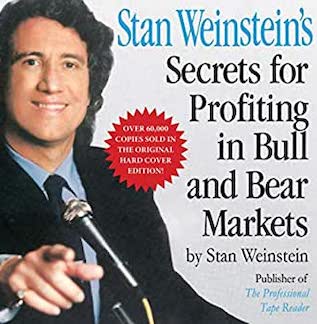 I’ve seen many traders refer to the book online and at some point it started to get my attention, which eventually triggered the interest to read the book. I haven’t seen Mr. Weinstein’s presence online, but he is a veteran already and probably retired as this book was first published in 1988. Stan Weinstein’s work is considered to be classical momentum trading that is to buy high and sell higher. I like to read an older trading book to see how the methodology has been playing out afterwards and if it has any relevance to today’s markets.
I’ve seen many traders refer to the book online and at some point it started to get my attention, which eventually triggered the interest to read the book. I haven’t seen Mr. Weinstein’s presence online, but he is a veteran already and probably retired as this book was first published in 1988. Stan Weinstein’s work is considered to be classical momentum trading that is to buy high and sell higher. I like to read an older trading book to see how the methodology has been playing out afterwards and if it has any relevance to today’s markets.
In the introduction to the book, the author reveals some background about his trading style. Indeed, he is looking for strength in stocks and had been trying different things for the past 25 years before writing the book in 1988, to see what worked and what didn’t. Thinking of the time period, it means he traded momentum in US stocks during the high inflationary ’70s, when the environment was tough for equities.
Stock charts
The way Weinstein starts to explain the terms of technical analysis and how to read charts gives an initial feel that it’s been written for complete beginners. On the other hand, his methodology isn’t too complicated and it shouldn’t be. Simple works. Stan makes charting look quite an easy task and I think it mostly is, but in reality analyzing a chart is a different task from actually trading it with real money. It’s often said that for an individual to trade his or her own money, it takes to be in two separate professions – an analyst and a trader.
The author shows many charts of price breakouts and also breakdowns. I’ve come to understand that there was less price noise and more clean trends back then due to less market participants and slower moves (no high-frequency trading, high trading commissions). That means the markets may have technically changed, like going electronic for example, but the human element with emotions remains.
Some things don’t change
Good points by the author that in my mind are still relevant today:
- One doesn’t need to know about fundamentals that lag behind, and definitely needs to avoid daily news that have already priced in by the time they are out.
- Higher trading volume is important on breakouts confirming there is strength behind buying. Without volume confirming, he suggests to pass it on and look for a next one.
- Relative strength must be improving, meaning the stock is doing relatively better than the overall market.
Stage analysis
Here I recognize the popular stage analysis example by Weinstein that is being shared on the web a lot. Basically, every stock is in one of the four stages: basing, advancing, topping or declining. Stan explains these stages in more detail. The job of a trader is to buy a stock that is starting to trend up after breaking out from the basing stage to the advancing one, and sell it when it’s starting to trend down after breaking down from the topping stage to the declining one. Of course, in real life it’s not as easy as in a textbook example.
Look-back period
A good point about resistance levels that I’ve subconsciously followed myself is that if it’s not seen in a chart’s look-back period, then it’s not important cause the market participants have likely changed for your timeframe. Going further, I like his reasoning why a new high in price is bullish and a good buy. When a stock is trading at a new high price it has never seen before, there is nobody long in the stock holding a loss, therefore no sellers creating overhead resistance.
Following price is timeless
It’s interesting to look at charts from the ’70-’80s drawn before I was born. But nevertheless, all the wisdom about price levels and momentum feels so timeless. It’s funny to read his statement that traders should use stop-loss orders because the stock market had become faster due to index futures and programmed trading. Over 30 years have passed, the markets are electronic with algorithms and high frequency trading.
Selling short
Stan debunks the myth that short selling is extremely risky and people shouldn’t do it by explaining how to manage risk with a hard stop-loss order. He warns about the common mistakes when selling a stock short like shorting a stock in an uptrend, because of a high P/E ratio or because the wider consensus is that the stock must crash. One should also look at trading volume to avoid shorting thinly traded stocks and to always place a protective buy-stop order to get out of the short when it’s going against you.
My conclusion
I can say it was an easy read for me cause I have studied the topic extensively, but I liked the book a lot. Weinstein got straight to the point. His trading method is robust and evergreen with the main idea to be invested in stocks trending up and protect capital while the market is going down. It all seems excellent in theory, but needs practice to make it work. I recommend this book to new and aspiring traders, who are looking to capture longer trends and want to hold on to bigger outliers.
Secrets for Profiting in Bull and Bear Markets by Stan Weinstein book link
Share this post